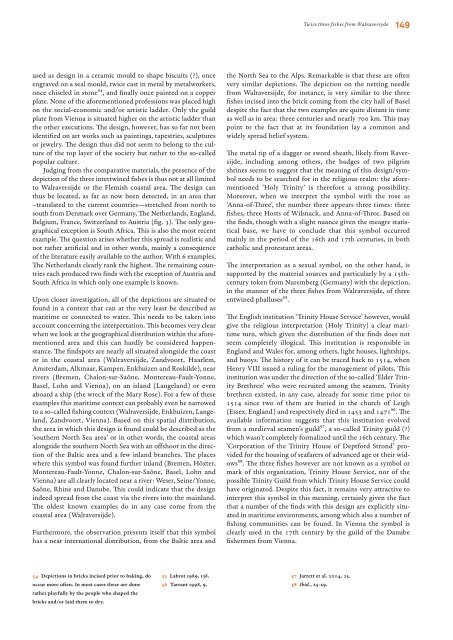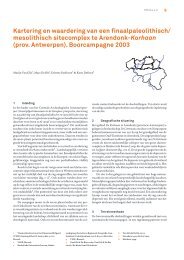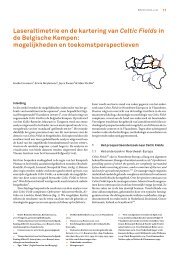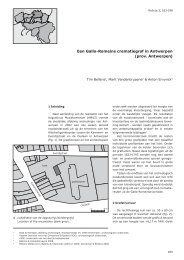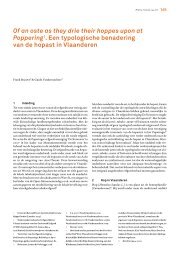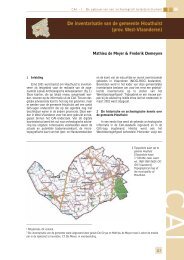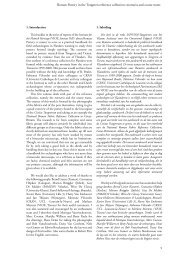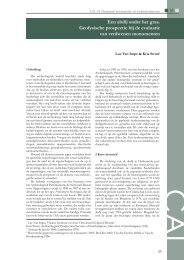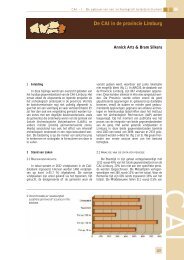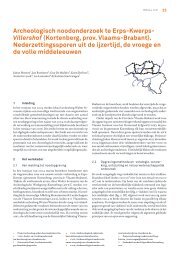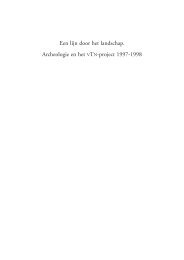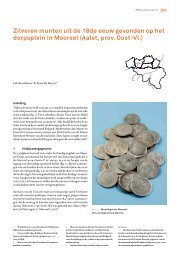Exchanging Medieval Material Culture Studies on archaeology and ...
Exchanging Medieval Material Culture Studies on archaeology and ...
Exchanging Medieval Material Culture Studies on archaeology and ...
Create successful ePaper yourself
Turn your PDF publications into a flip-book with our unique Google optimized e-Paper software.
used as design in a ceramic mould to shape biscuits (?), <strong>on</strong>ce<br />
engraved <strong>on</strong> a seal mould, twice cast in metal by metalworkers,<br />
<strong>on</strong>ce chiseled in st<strong>on</strong>e54, <strong>and</strong> fi nally <strong>on</strong>ce painted <strong>on</strong> a copper<br />
plate. N<strong>on</strong>e of the aforementi<strong>on</strong>ed professi<strong>on</strong>s was placed high<br />
<strong>on</strong> the social-ec<strong>on</strong>omic <strong>and</strong>/or artistic ladder. Only the guild<br />
plate from Vienna is situated higher <strong>on</strong> the artistic ladder than<br />
the other executi<strong>on</strong>s. Th e design, however, has so far not been<br />
identifi ed <strong>on</strong> art works such as paintings, tapestries, sculptures<br />
or jewelry. Th e design thus did not seem to bel<strong>on</strong>g to the culture<br />
of the top layer of the society but rather to the so-called<br />
popular culture.<br />
Judging from the comparative materials, the presence of the<br />
depicti<strong>on</strong> of the three intertwined fi shes is thus not at all limited<br />
to Walraversijde or the Flemish coastal area. Th e design can<br />
thus be located, as far as now been detected, in an area that<br />
–translated to the current countries—stretched from north to<br />
south from Denmark over Germany, Th e Nether l<strong>and</strong>s, Engl<strong>and</strong>,<br />
Belgium, France, Switzerl<strong>and</strong> to Austria (fi g. 3). Th e <strong>on</strong>ly geographical<br />
excepti<strong>on</strong> is South Africa. Th is is also the most recent<br />
example. Th e questi<strong>on</strong> arises whether this spread is realistic <strong>and</strong><br />
not rather artifi cial <strong>and</strong> in other words, mainly a c<strong>on</strong>sequence<br />
of the literature easily available to the author. With 6 examples,<br />
Th e Netherl<strong>and</strong>s clearly rank the highest. Th e remaining countries<br />
each produced two fi nds with the excepti<strong>on</strong> of Austria <strong>and</strong><br />
South Africa in which <strong>on</strong>ly <strong>on</strong>e example is known.<br />
Up<strong>on</strong> closer investigati<strong>on</strong>, all of the depicti<strong>on</strong>s are situated or<br />
found in a c<strong>on</strong>text that can at the very least be described as<br />
maritime or c<strong>on</strong>nected to water. Th is needs to be taken into<br />
account c<strong>on</strong>cerning the interpretati<strong>on</strong>. Th is becomes very clear<br />
when we look at the geographical distributi<strong>on</strong> within the aforementi<strong>on</strong>ed<br />
area <strong>and</strong> this can hardly be c<strong>on</strong>sidered happenstance.<br />
Th e fi ndspots are nearly all situated al<strong>on</strong>gside the coast<br />
or in the coastal area (Walraversijde, Z<strong>and</strong>voort, Haarlem,<br />
Amsterdam, Alkmaar, Kampen, Enkhuizen <strong>and</strong> Roskilde), near<br />
rivers (Bremen, Chal<strong>on</strong>-sur-Saône, M<strong>on</strong>tereau-Fault-Y<strong>on</strong>ne,<br />
Basel, Lohn <strong>and</strong> Vienna), <strong>on</strong> an isl<strong>and</strong> (Langel<strong>and</strong>) or even<br />
aboard a ship (the wreck of the Mary Rose). For a few of these<br />
examples this maritime c<strong>on</strong>text can probably even be narrowed<br />
to a so-called fi shing c<strong>on</strong>text (Walraversijde, Enkhuizen, Langel<strong>and</strong>,<br />
Z<strong>and</strong>voort, Vienna). Based <strong>on</strong> this spatial distributi<strong>on</strong>,<br />
the area in which this design is found could be described as the<br />
‘southern North Sea area’ or in other words, the coastal areas<br />
al<strong>on</strong>gside the southern North Sea with an off shoot in the directi<strong>on</strong><br />
of the Baltic area <strong>and</strong> a few inl<strong>and</strong> branches. Th e places<br />
where this symbol was found further inl<strong>and</strong> (Bremen, Höxter,<br />
M<strong>on</strong>tereau-Fault-Y<strong>on</strong>ne, Chal<strong>on</strong>-sur-Saône, Basel, Lohn <strong>and</strong><br />
Vienna) are all clearly located near a river: Weser, Seine/Y<strong>on</strong>ne,<br />
Saône, Rhine <strong>and</strong> Danube. Th is could indicate that the design<br />
indeed spread from the coast via the rivers into the mainl<strong>and</strong>.<br />
Th e oldest known examples do in any case come from the<br />
coastal area (Walraversijde).<br />
Furthermore, the observati<strong>on</strong> presents itself that this symbol<br />
has a near internati<strong>on</strong>al distributi<strong>on</strong>, from the Baltic area <strong>and</strong><br />
54 Depicti<strong>on</strong>s in bricks incised prior to baking, do<br />
occur more oft en. In most cases these are d<strong>on</strong>e<br />
rather playfully by the people who shaped the<br />
bricks <strong>and</strong>/or laid them to dry.<br />
55 Labrot 1989, 138.<br />
56 Tarrant 1998, 9.<br />
Twice three fishes from Walraversyde 149<br />
the North Sea to the Alps. Remarkable is that these are oft en<br />
very similar depicti<strong>on</strong>s. Th e depicti<strong>on</strong> <strong>on</strong> the netting needle<br />
from Walraversijde, for instance, is very similar to the three<br />
fi shes incised into the brick coming from the city hall of Basel<br />
despite the fact that the two examples are quite distant in time<br />
as well as in area: three centuries <strong>and</strong> nearly 700 km. Th is may<br />
point to the fact that at its foundati<strong>on</strong> lay a comm<strong>on</strong> <strong>and</strong><br />
widely spread belief system.<br />
Th e metal tip of a dagger or sword sheath, likely from Raversijde,<br />
including am<strong>on</strong>g others, the badges of two pilgrim<br />
shrines seems to suggest that the meaning of this design/symbol<br />
needs to be searched for in the religious realm: the aforementi<strong>on</strong>ed<br />
‘Holy Trinity’ is therefore a str<strong>on</strong>g possibility.<br />
Moreover, when we interpret the symbol with the rose as<br />
‘Anna-of-Th ree’, the number three appears three times: three<br />
fi shes, three Hosts of Wilsnack, <strong>and</strong> Anna-of-Th ree. Based <strong>on</strong><br />
the fi nds, though with a slight nuance given the meagre statistical<br />
base, we have to c<strong>on</strong>clude that this symbol occurred<br />
mainly in the period of the 16th <strong>and</strong> 17th centuries, in both<br />
catholic <strong>and</strong> protestant areas.<br />
Th e interpretati<strong>on</strong> as a sexual symbol, <strong>on</strong> the other h<strong>and</strong>, is<br />
supported by the material sources <strong>and</strong> particularly by a 15thcentury<br />
token from Nuremberg (Germany) with the depicti<strong>on</strong>,<br />
in the manner of the three fi shes from Walraversijde, of three<br />
entwined phalluses55.<br />
Th e English instituti<strong>on</strong> ‘Trinity House Service’ however, would<br />
give the religious interpretati<strong>on</strong> (Holy Trinity) a clear maritime<br />
turn, which given the distributi<strong>on</strong> of the fi nds does not<br />
seem completely illogical. Th is instituti<strong>on</strong> is resp<strong>on</strong>sible in<br />
Engl<strong>and</strong> <strong>and</strong> Wales for, am<strong>on</strong>g others, light houses, lightships,<br />
<strong>and</strong> buoys. Th e history of it can be traced back to 1514, when<br />
Henry VIII issued a ruling for the management of pilots. Th is<br />
instituti<strong>on</strong> was under the directi<strong>on</strong> of the so-called ‘Elder Trinity<br />
Brethren’ who were recruited am<strong>on</strong>g the seamen. Trinity<br />
brethren existed, in any case, already for some time prior to<br />
1514 since two of them are buried in the church of Leigh<br />
(Essex, Engl<strong>and</strong>) <strong>and</strong> respectively died in 1453 <strong>and</strong> 147156. Th e<br />
available informati<strong>on</strong> suggests that this instituti<strong>on</strong> evolved<br />
from a medieval seamen’s guild57, a so-called Trinity guild (?)<br />
which wasn’t completely formalized until the 16th century. Th e<br />
‘Corporati<strong>on</strong> of the Trinity House of Deptford Str<strong>on</strong>d’ provided<br />
for the housing of seafarers of advanced age or their widows58.<br />
Th e three fi shes however are not known as a symbol or<br />
mark of this organizati<strong>on</strong>, Trinity House Service, nor of the<br />
possible Trinity Guild from which Trinity House Service could<br />
have originated. Despite this fact, it remains very attractive to<br />
interpret this symbol in this meaning, certainly given the fact<br />
that a number of the fi nds with this design are explicitly situated<br />
in maritime envir<strong>on</strong>ments, am<strong>on</strong>g which also a number of<br />
fi shing communities can be found. In Vienna the symbol is<br />
clearly used in the 17th century by the guild of the Danube<br />
fi shermen from Vienna.<br />
57 Jarrett et al. 2004, 25.<br />
58 Ibid., 25-29.


